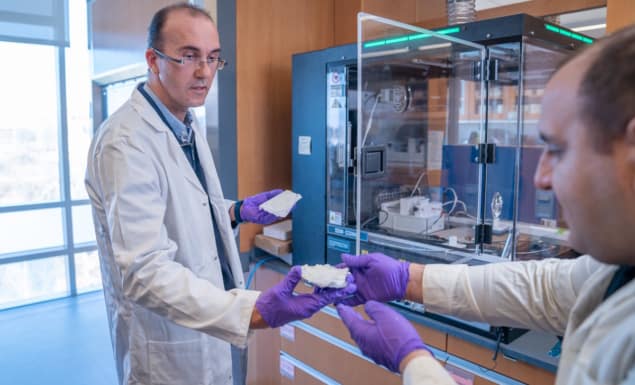
Wound healing is a complex procedure that represents an important healthcare challenge. Most medical dressings used on wounds are made from cotton gauze, which is biocompatible, breathable, absorbent and soft – but doesn’t promote healing or fight infection. What’s needed is a smart dressing that helps speed the healing process while proactively combating infection.
A research team at Cornell University is addressing this challenge, boosting the performance of cotton dressings by coating them with a layer of biologically active nanofibres. The nanofibres harness the antioxidant, anti-inflammatory and antibacterial properties of a lawsone, a botanical compound found abundantly in henna leaves.
Lawsone’s therapeutic properties make it an intriguing candidate for wound management, but its limited solubility makes it tricky to incorporate into dressings. Instead, the researchers used cyclodextrins, natural oligosaccharides produced from starch, to create inclusion complexes that bind lawsone molecules inside. This process enhances lawsone’s solubility, stability and bioavailability, and could increase its therapeutic impact. Crucially, cyclodextrins are compatible with electrospinning, making them suitable for creating nanofibre coatings on cotton substrates.
“The prolonged overuse of synthetic antibiotics in high concentrations has contributed to the rise of the deadly epidemic of multidrug-resistant microbes,” says Tamer Uyar, director of the NanoFibers and NanoTextiles Laboratory, in a press statement. “The use of natural and potent anti-bacterials such as lawsone may serve as an alternative to synthetic anti-bacterials.”
Bioactive agent
Uyar and colleagues used two cyclodextrins – HP-β-CD and HP-γ-CD – to create inclusion complexes with CD/lawsone ratios of 2:1 and 4:1 M. They then employed electrospinning technology to fabricate CD/lawsone nanofibrous webs with average fibre diameters of around 300–700 nm.
One valuable way to enhance healing is to reduce oxidative stress in the wound microenvironment. The team investigated the antioxidant properties of the nanofibres using a DPPH radical scavenging technique. This DPPH test involved mixing the nanofibrous webs into distilled water, adding methanolic DPPH solution and then using UV–visible spectroscopy to measure the decrease in DPPH absorption over time.
Nanofibres with a 2:1 M CD/lawsone ratio showed higher antioxidant activity (due to the higher lawsone content), while HP-β-CD showed greater activity than HP-γ-CD. The antioxidant activity increased with time, escalating from approximately 20% at 1 h to around 65% at 24 h, for HP-β-CD/lawsone 2:1 nanofibres.
The researchers point out that the nanofibrous samples exhibited significantly higher antioxidant activity – and thus the potential for faster wound healing – than pure lawsone. They attribute this to the increased solubility conferred by CD inclusion and the high surface-to-volume ratio of the nanofibrous web.
As well as encouraging wound healing, a smart dressing should help prevent and eradicate infections. As such, the researchers evaluated the nanofibres’ activity against two prominent bacterial strains: gram-negative E. coli and gram-positive S. aureus. They dissolved nanofibrous samples in bacterial solutions, incubated the samples at 37°C for 24 h, and then plated them for colony counting.
Untreated negative control samples did not show any antimicrobial activity and bacteria continued to grow. In contrast, all four nanofibre types demonstrated potent antimicrobial activity, completely eradicating both E. coli and S. aureus bacteria, as seen by the absence of colonies on the culture plates. There was no difference in the effect of nanofibres with 4:1 and 2:1 molar ratios, indicating that even those with lower lawsone content possessed sufficient antibacterial activity.
Rapid release
Selecting HP-β-CD/lawsone 4:1 and HP-γ-CD/lawsone 4:1 as optimal candidates for creating dressings, the researchers coated cotton substrates with nanofibrous samples to investigate their ability to release the lawsone. They immersed the nanofibre-coated samples in a PBS solution and placed them on an orbital shaker at 37 °C. They then assessed the cumulative release of lawsone by analysing small samples removed at specific time intervals.
Most of the lawsone content, approximately 84% in HP-β-CD/lawsone 4:1 and 77% in HP-γ-CD/lawsone 4:1, was released within the initial 30 s. This pronounced initial release is attributed to the rapid dissolution of the nanofibre coating, which was completed after 3 min, at which time all of the lawsone was released. The researchers note that the release profile exhibited by the cotton-coated samples mirrored that of free-standing fibres.

Paintable bioactive ink heals wounds of any shape or size
“This study advances the realm of wound management by enhancing lawsone activity through the inclusion complexation and functionalizing cotton through CD/lawsone nanofibre coatings,” the team concludes. “With promising antibacterial and antioxidant attributes, this innovative method holds significant promise for the development of biofunctional wound dressings with enhanced therapeutic potential.”
The team is now investigating other bioactive agents. “The next steps will be testing their cytotoxicity, anti-inflammatory tests and in vivo studies for wound healing,” Uyar tells Physics World.
The research is described in International Journal of Pharmaceutics.
- SEO Powered Content & PR Distribution. Get Amplified Today.
- PlatoData.Network Vertical Generative Ai. Empower Yourself. Access Here.
- PlatoAiStream. Web3 Intelligence. Knowledge Amplified. Access Here.
- PlatoESG. Carbon, CleanTech, Energy, Environment, Solar, Waste Management. Access Here.
- PlatoHealth. Biotech and Clinical Trials Intelligence. Access Here.
- Source: https://physicsworld.com/a/nanofibre-coated-bandage-fights-infection-and-helps-heal-wounds/



